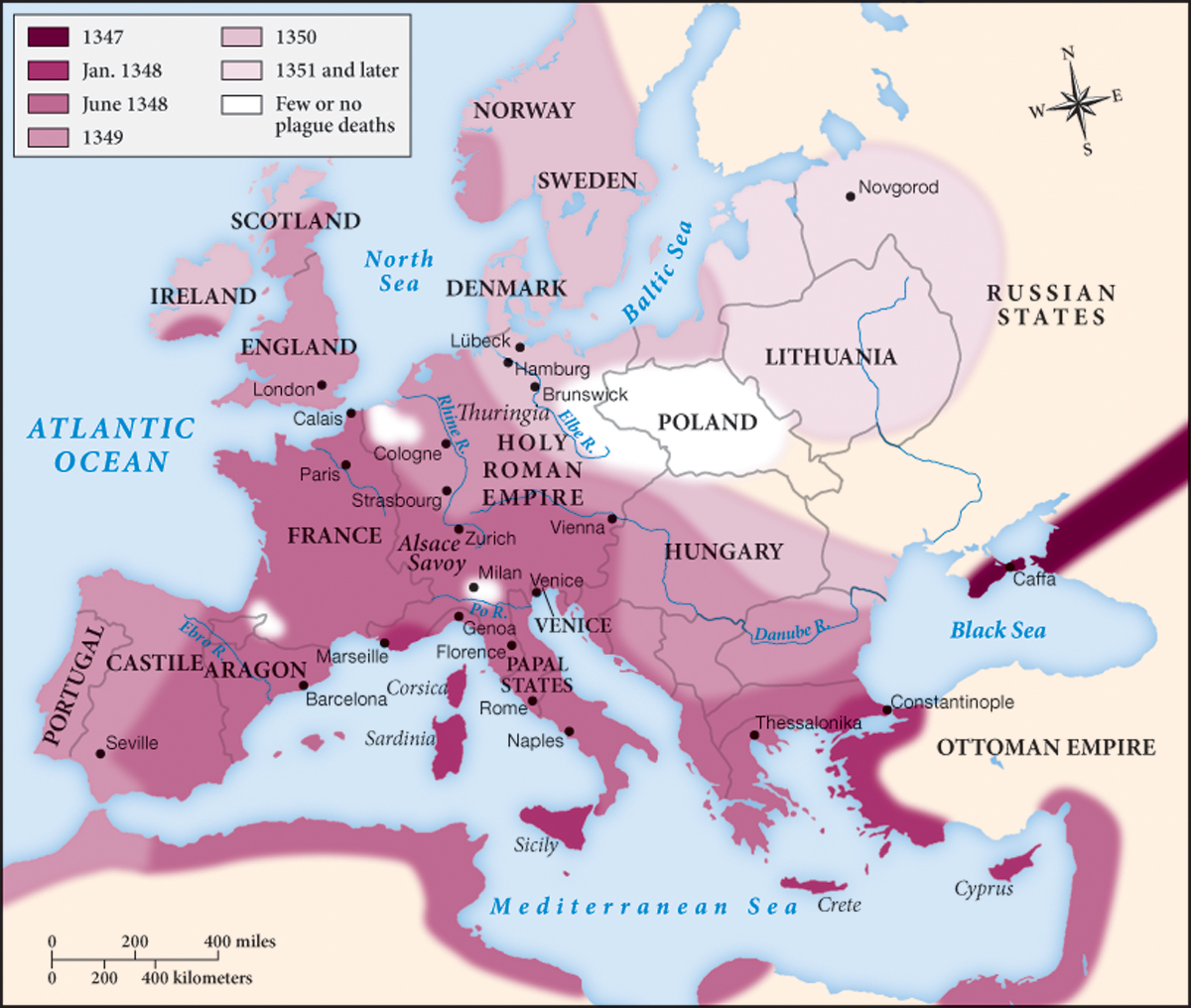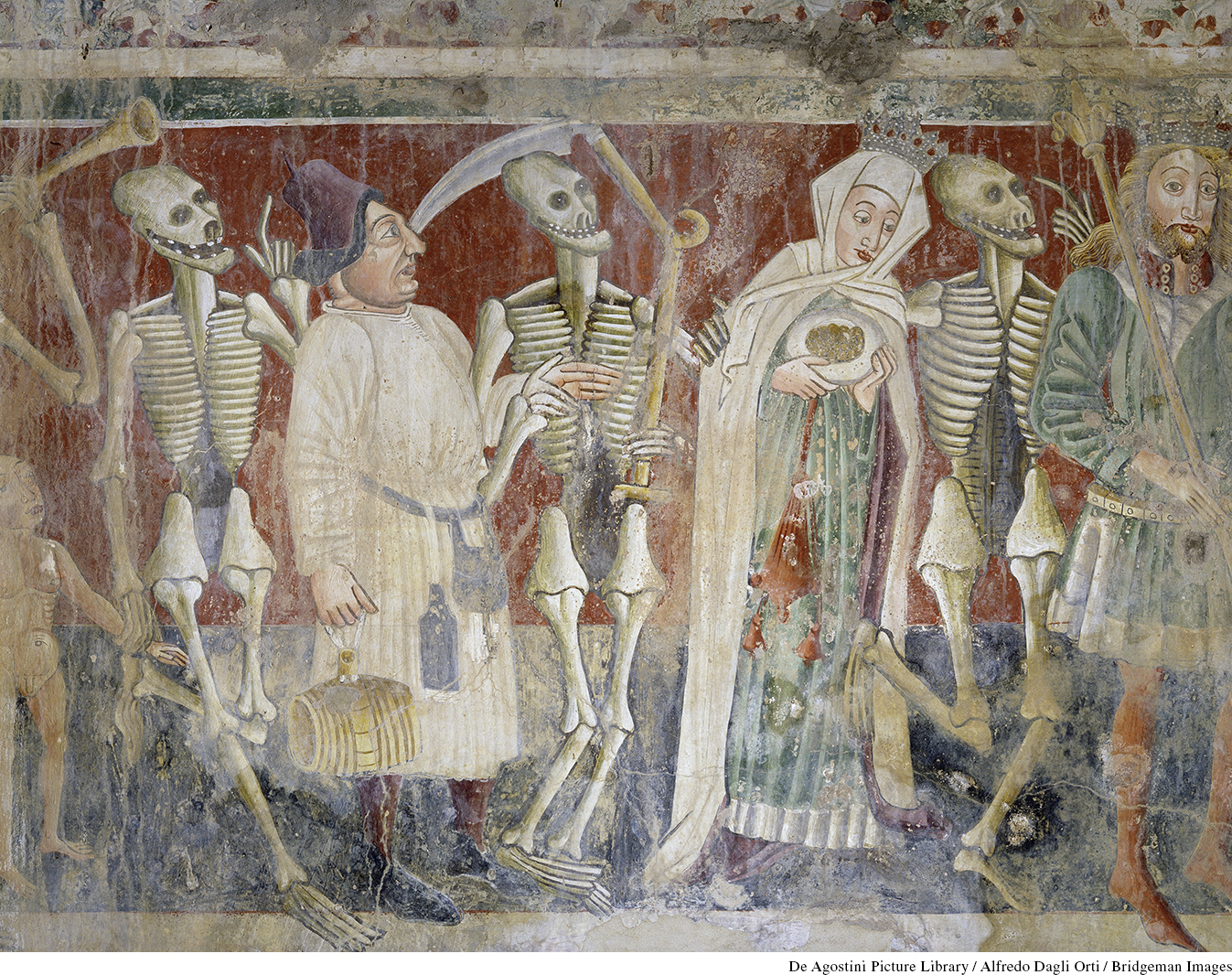The Black Death, 1346–1353
Printed Page 410
Important EventsThe Black Death, 1346–1353
The Black Death, so named by later historians, was a calamitous disease. It decimated the population wherever it struck and wreaked havoc on social and economic structures. Yet in the wake of this plague, those fortunate enough to survive benefited from an improved standard of living. Birthrates climbed, and new universities were established to educate the post-plague generations.
Already in 1346, the Byzantine scholar Nicephorus Gregoras noted a new disease and described its symptoms, including “tumorous outgrowths at the roots of thighs and arms and simultaneously bleeding ulcerations.” Scientists now ascribe the Black Death to the bacterium Yersinia pestis, the same organism responsible for outbreaks of plague today.
Carried by fleas traveling on the backs of rats, the Black Death hitched boat rides with spices, silks, and porcelain. It hit the Genoese colony in Caffa in 1347 and soon arrived in Constantinople and southern Europe. It then crept northward to Germany, England, Scandinavia, and the state that now was starting to be called Russia.* Meanwhile, it attacked the Islamic world as well (Map 13.1). Recurring every ten to twelve years throughout the fourteenth century (though only the outbreak of 1346–1353 is called the Black Death), the disease attacked, with decreasing frequency, until the eighteenth century.

The effects of the Black Death were spread across Europe yet oddly localized. At Florence, in Italy, nearly half of the population died, yet two hundred miles to the north, Milan suffered very little. Conservative estimates put the death toll in Europe anywhere between 30 and 50 percent of the entire population, but some historians put the mortality rate as high as 60 percent. (See “Taking Measure: Population Losses and the Black Death.”) Already weakened by the Great Famine as well as by local food shortages and epidemic diseases like smallpox, Europeans were devastated by the arrival of Yersinia.
Many localities sought remedies. The government of the Italian city of Pistoia, for example, set up a quarantine and demanded better sanitation. Elsewhere reactions were religious. In England, the archbishop of York tried to prevent the plague from entering his diocese by ordering “devout processions.” Some people took more extreme measures. Lamenting their sins—which they believed had brought on the plague—and attempting to placate God, flagellants, men (with women praying), wandered from city to city whipping themselves. Religious enthusiasm often culminated in violence against the Jews, who were blamed for the Black Death. In Germany, thousands of Jews were slaughtered. Many Jews fled to Poland, where the epidemic affected fewer people and where the authorities welcomed Jews as productive taxpayers.

Preoccupation with death led to the popularity of a theme called the Dance of Death as a subject of art, literature, and performance. It featured a procession of people of every age, sex, and rank making their way to the grave. In works of art, skeletal figures of Death, whirling about, laughed as they abducted their prey. Preachers, poets, and playwrights relished the theme.
At the same time that it helped inspire this bleak view of the world, the Black Death brought new opportunities for those who survived its murderous path. With a smaller population to feed, less land was needed for cultivation. Landlords allowed marginal land that had been cultivated to return to pasture, meadow, or forest, and they diversified their products. Wheat had been the favored crop before the plague, but barley—the key ingredient of beer—turned out to be more profitable afterward. Animal products continued to fetch a high price, and some landlords switched from raising crops to raising animals.
These changes in agriculture meant a better standard of living. The peasants and urban workers who survived the plague were able to negotiate better conditions or higher wages from their landlords or employers. With more money to spend, people could afford a better and more varied diet that included beer and meat. Birthrates jumped as people could afford to marry at younger ages.
The Black Death, which spared neither professors nor students, also affected patterns of education. The survivors built new local colleges and universities, partly to train a new generation for the priesthood and partly to satisfy local donors—many of them princes—who, riding on a sea of wealth left behind by the dead, wanted to be known as patrons of education. Thus, in 1348, in the midst of the Black Death, Holy Roman Emperor Charles IV chartered a university at Prague. The king of Poland founded Cracow University, and a Habsburg duke created a university at Vienna. Rather than traveling to Paris or Bologna, young men living east of the Rhine River now tended to study nearer home.